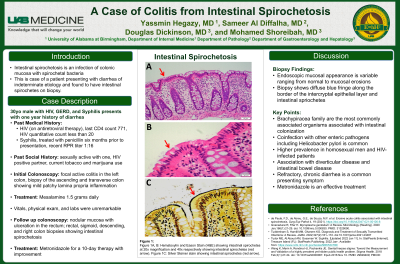Back


Poster Session B - Monday Morning
Category: Colon
B0148 - A Case of Colitis From Intestinal Spirochetosis
Monday, October 24, 2022
10:00 AM – 12:00 PM ET
Location: Crown Ballroom

Has Audio
- YH
Yassmin Hegazy, MD
University of Alabama at Birmingham
Birmingham, AL
Presenting Author(s)
Yassmin Hegazy, MD1, Sameer Al Diffalha, MD1, Douglas Dickinson, MD1, Mohamed Shoreibah, MD2
1University of Alabama at Birmingham, Birmingham, AL; 2University of Alabama Birmingham, Birmingham, AL
Introduction: A thirty-year-old homosexual male with a history of Human Immunodeficiency Virus (HIV), Gastroesophageal Reflux Disease (GERD), and syphilis presents to clinic with chronic diarrhea from indeterminate colitis and is found to have intestinal spirochetosis.
Case Description/Methods: Patient with a history of HIV, compliant with antiviral therapy on elvitegravir, cobicistat, emtricitabine, and tenofovir with his last Cluster of Differentiation (CD4) count of 771 and HIV quantitative count less than 20 presents to clinic with continued diarrhea for the past year. Initial workup included a colonoscopy showing focal active colitis in the left colon with biopsy of the ascending and transverse colon showing mild patchy lamina propria inflammation where he was started on mesalamine 1.5 grams daily. Patient also with a history of syphilis that was treated with penicillin six months prior to presentation with recent Rapid Plasma Reagin (RPR) titer 1:16. Social history was notable for active sexual activity with one, HIV positive male partner as well as current tobacco and marijuana use. He reports 4-5 bowel movements per day and recent rectal condyloma with pathology showing low-grade squamous intraepithelial lesion. Vitals, physical exam, and labs were unremarkable. Patient underwent a follow up colonoscopy with findings significant for nodular mucosa with ulceration in the rectum as well as rectal, sigmoid, descending, and right colon biopsies showing intestinal spirochetosis (Figure 1). Patient was started on metronidazole for a 10-day therapy with improvement.
Discussion: Intestinal spirochetosis is characterized by spirochetes on the luminal surface of colorectal mucosa with a higher prevalence in homosexual men and HIV-infected patients. Previous studies found an association with diverticular disease and intestinal bowel disease with diarrhea as a common presenting symptom seen in our patient. The Brachypiracea family are the most common organisms associated with intestinal colonization with co-infection with other enteric pathogens including Helicobacter pylori being common. Endoscopic mucosal appearance can be variable ranging from normal to mucosal erosions with diagnosis made with biopsy showing a diffuse fringe along the border of the intercryptal epithelial layer (Figure 1) and metronidazole being an effective treatment. When an immunocompromised patient with high risk behaviors presents with chronic diarrhea, intestinal spirochetes should be considered on the differential diagnosis.

Disclosures:
Yassmin Hegazy, MD1, Sameer Al Diffalha, MD1, Douglas Dickinson, MD1, Mohamed Shoreibah, MD2. B0148 - A Case of Colitis From Intestinal Spirochetosis, ACG 2022 Annual Scientific Meeting Abstracts. Charlotte, NC: American College of Gastroenterology.
1University of Alabama at Birmingham, Birmingham, AL; 2University of Alabama Birmingham, Birmingham, AL
Introduction: A thirty-year-old homosexual male with a history of Human Immunodeficiency Virus (HIV), Gastroesophageal Reflux Disease (GERD), and syphilis presents to clinic with chronic diarrhea from indeterminate colitis and is found to have intestinal spirochetosis.
Case Description/Methods: Patient with a history of HIV, compliant with antiviral therapy on elvitegravir, cobicistat, emtricitabine, and tenofovir with his last Cluster of Differentiation (CD4) count of 771 and HIV quantitative count less than 20 presents to clinic with continued diarrhea for the past year. Initial workup included a colonoscopy showing focal active colitis in the left colon with biopsy of the ascending and transverse colon showing mild patchy lamina propria inflammation where he was started on mesalamine 1.5 grams daily. Patient also with a history of syphilis that was treated with penicillin six months prior to presentation with recent Rapid Plasma Reagin (RPR) titer 1:16. Social history was notable for active sexual activity with one, HIV positive male partner as well as current tobacco and marijuana use. He reports 4-5 bowel movements per day and recent rectal condyloma with pathology showing low-grade squamous intraepithelial lesion. Vitals, physical exam, and labs were unremarkable. Patient underwent a follow up colonoscopy with findings significant for nodular mucosa with ulceration in the rectum as well as rectal, sigmoid, descending, and right colon biopsies showing intestinal spirochetosis (Figure 1). Patient was started on metronidazole for a 10-day therapy with improvement.
Discussion: Intestinal spirochetosis is characterized by spirochetes on the luminal surface of colorectal mucosa with a higher prevalence in homosexual men and HIV-infected patients. Previous studies found an association with diverticular disease and intestinal bowel disease with diarrhea as a common presenting symptom seen in our patient. The Brachypiracea family are the most common organisms associated with intestinal colonization with co-infection with other enteric pathogens including Helicobacter pylori being common. Endoscopic mucosal appearance can be variable ranging from normal to mucosal erosions with diagnosis made with biopsy showing a diffuse fringe along the border of the intercryptal epithelial layer (Figure 1) and metronidazole being an effective treatment. When an immunocompromised patient with high risk behaviors presents with chronic diarrhea, intestinal spirochetes should be considered on the differential diagnosis.

Figure: Figure 1A, B: Hematoxylin and Eason Stain (H&E) showing intestinal spirochetes at 20x magnification and 40x respectively showing intestinal spirochetes (red arrow). Figure 1C: Silver Steiner stain showing intestinal spirochetes (red arrow).
Disclosures:
Yassmin Hegazy indicated no relevant financial relationships.
Sameer Al Diffalha indicated no relevant financial relationships.
Douglas Dickinson indicated no relevant financial relationships.
Mohamed Shoreibah indicated no relevant financial relationships.
Yassmin Hegazy, MD1, Sameer Al Diffalha, MD1, Douglas Dickinson, MD1, Mohamed Shoreibah, MD2. B0148 - A Case of Colitis From Intestinal Spirochetosis, ACG 2022 Annual Scientific Meeting Abstracts. Charlotte, NC: American College of Gastroenterology.
